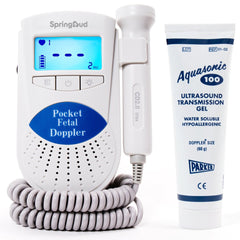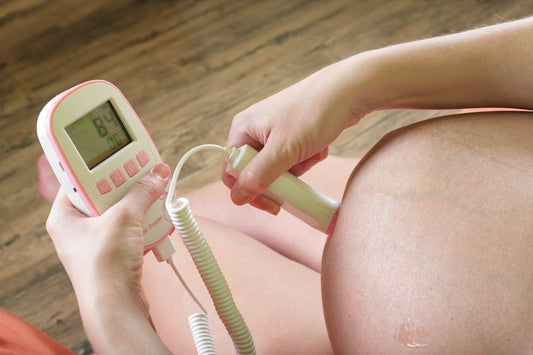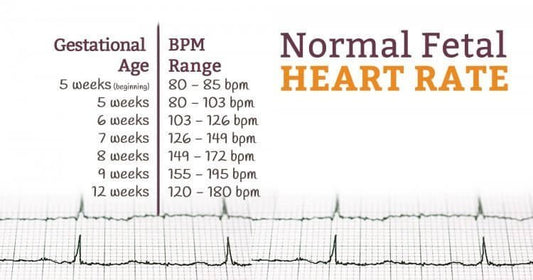
Fetal Doppler is the magic gadget for first-time moms. This device is used to listen to your baby’s heartbeats and monitor it. We know that being a mother, it’s spellbinding to hear your baby’s heart rhythm for the very first time. Even if it’s your second or third child, we (as mothers) completely understand your level of excitement. However, a study featured in Journal of Ultrasound in Medicine says “obstetrics and gynecology resident knowledge of obstetric ultrasound safety is low” all across America. Therefore, here we have a complete guide for those who have just stepped into the world of pregnancy.
Here comes the question:
Is fetal doppler safe?
Though fetal dopplers are widely utilized yet new-parents are reluctant to use this device. The basic reason lies in misinterpretation of FDA’s (US Food and Drug Administration) medical professional comments. Even American Journal of Clinical Obstetrics and Gynecology guarantees that ultrasound based examination of fetus does not harm baby.
“Ultrasound's record of safety seems to be perfect, with no undisputed reports of adverse effects in humans”.
However, many new-parents have no clue about the usage guidelines and even the purpose of these handy devices. So, here is the story from the beginning!
After almost 8 weeks of a positive pregnancy test, your doctor may recommend you to schedule an initial ultrasound (in some cases the first ultrasound is not performed until the eleventh week). By employing some machines, you would be able to “hear” your baby’s heartbeat. Amazing right? Yes! We know that the sweet sound of a pulsating heart not only gives you affirmation, but also soothes you. Therefore, for most of the parents, it is a common desire to hear it, again and again. As most of you can’t visit a doctor in a loop. For this reason, fetal dopplers are used, as they lighten the burden of regular doctor’s appointments. However, we recommend using these at home, with proper doctor’s consultation and complete training. Although we understand that this device strengthens your emotional bond with your unborn blessed soul, yet we strongly advocate for healthcare instructions laid by the government.
What Is A Baby's Heartbeat?
Baby’s heartbeat is called a fetal heartbeat and it is the prime indicator of your baby’s fetal health. This heart rhythm not only calms the parents, but also provides strong health indications to the doctor. That is the reason, generally, from the second trimester the baby's heartbeat is regularly monitored to overrule any pregnancy complexities. So what is the normal rate for babies? You might be thinking it to be lower than adults, but the truth is astonishing. Johns Hopkins Medicine Health Library claims that fetal heartbeat rate should be around 110-160/minute in late pregnancy and even during the labor. That is why; fetal dopplers are one of these widely used machines, as they are helpful in keeping track of baby’s health. Doctors commonly utilize ultrasound machines to detect and monitor fetal heartbeats. However, many parents use these devices at home, for convenience (after consulting doctors and taking apt training).
How Does Fetal Doppler Work?
Fetal Doppler is a handheld device which detects heartbeats by using sound waves. These are similar to ultrasound machines, but the frequencies used in these devices are relatively low. It works on the scientific principle called The “Doppler effect” (yes that is from where it got this name, not from drops, okay bad joke!). Doppler’s effect explains how waves change with the distance. This principle utilizes sound waves to tell about the direction of a moving object; either it is coming closer or moving away. Fetal Doppler operates on the same principle to detect the back and forth movement of a heartbeat. So it basically utilized ultrasound waves to detect the heart rate. In an article (Ultrasound in obstetrics: a review of safety) of European Journal of Obstetrics & Gynecology and Reproductive Biology authors (Hershkovitz, Reli, Eyal Sheiner, and Moshe Mazor) says:
“Ultra sound waves has no adverse effect on embryogenesis or fetal growth”
The only effect of ultra sound waves is heat. As these waves (like all other waves) carry energy therefore, when they penetrate through tissues they lose energy in form of heat. FDA biomedical engineer explains,
“Ultrasound can heat tissues slightly, and in some cases, it can also produce very small bubbles (cavitation) in some tissues.”
However, this effect does not lie in the grey area. Therefore, during the second trimester (week 13 to week 28) a major faction of pregnant women utilizes these devices to hear their respective baby’s heartbeats. However, it is not a proper “embryo health test”, though it can be used for routine check. For a complete health test we recommend you to periodically consult your doctor.
How To Use Fetal Doppler?
If you go to the clinic
Then a technician will do the trick for you. All you need to do is to lie down on your back, and let her/him slide a probe over your belly. The probe will send sound waves down your belly, and when they will strike at your baby’s heart, they will send a signal to the machine. The machine will decode and amplify the signals to make them audible. During this entire process you would need to stay still; in order to avoid misreading.
If you decide to perform this test at home
After consulting the doctor, then you should follow the fetal Doppler’s manual. Generally, the procedure starts with inserting the batteries in the device and turning it on. Subsequently, aloe vera gel or sonogram gel is applied at the belly. Afterward, you will need to lie down on your back, in a comfortable position (so that you do not move unnecessarily). Then move the probe slowly (without putting pressure) on your lower belly. Here you need to keep in mind that getting no signal is normal, as most of the mothers are not professionals, and therefore, the chance of having false signals are higher. However, try to move the probe below your belly button, in a rhythmic motion, to detect the baby's heartbeat. The only trick to identify whether it is your own heartbeat or your unborn baby’s is to observe the beat counts. The rule of thumb is that baby’s heartbeats are faster than adults. So, you can easily distinguish it. You may also find more tips to detect fetal heartbeat properly.

Can Fetal Doppler Harm Baby?
The potential risks are predominantly mental, which can ultimately cause physical risks. Using fetal Doppler is not a cakewalk; you need to know the dynamics. Therefore, many mothers fail to use it properly and end-up risking their baby’s life. Chanchani (a clinical assistant professor of obstetrics and gynecology at NYU Langone Health, New York City) has these views on fetal doppler usage:
“They provide real-time information about whether or not the heart rate of a baby is normal. The risk of using fetal Dopplers at home is not in the technology. The actual risk is in misinterpreting the fetal heart rate.”
Commonly, many pregnant women are extra-conscious about their baby’s well-being. That is why; they use a fetal Doppler to keep track of their baby’s health. In such cases, when they miss the heartbeats due to inexperience, they usually get panicked. Moreover, in many instances, mothers falsely perceive their own heartbeat as their baby’s. Therefore, the device should be used attentively.
How Often To Use Fetal Doppler?
The precise number varies in each case (depending upon mother’s health and case-history). However, general frequency of usage lies between one to three times in a day (1~3 times/day), for not more than 120 seconds each. Barnett, Stanley B., et al. suggested in their publication of "International recommendations and guidelines for the safe use of diagnostic ultrasound in medicine", that prolonged exposure to even mild ultrasound waves should be avoided. (Ultrasound in medicine & biology 26.3 (2000): 355-366). Therefore, consult your doctor to gauge the safe limit for you.
Why Use Fetal Doppler?
Keeping an eye on the baby's health is the central task to every mom. Critical Care Clinics Editions of Elsevier Journal has a review article (Cranial Doppler applications in neonatal critical care) on doppler’s usage and safety. In the said publication the author (Raju Tonse NK) strongly endorsed fetal doppler as a baby’s health tracker. He says:
“The Doppler derived information has been considered to be of value in the clinical management of cases with shock, asphyxia, brain death, vascular malformations, and increased intracranial pressure in the fetus and the newborn. Doppler techniques are also used in a variety of physiologic studies related to neonatal cerebral blood flow.”
Therefore, these medical practitioners use it to keep track of baby’s health. However, we completely understand that parents have a diverging reason for the usage of fetal Doppler; which roots down to parent-child emotional bonding. Pregnancy is all about a train of emotions. It is a “feeling”; a journey with your unseen love. Therefore, you search for gadgets which connect you with your always-wanted piece of soul. Many couples use it frequently to inadvertently communicate with the baby. Most of the time, fathers use these devices to create an emotional connection with their respective beloved baby. That is why when public over-utilized it then FDA (US Food and Drug Administration) banned the product. So, use it as per doctor’s recommendation.
Is Fetal Doppler Safe?
American Scientist Bernstine, R. L. performed clinical study of 720 obstetric patients and after thoroughly examining their tissue culture, he concluded that fetal dopplers are safe to use. In his words:
“Doppler inspection of the fetus, as presently practiced, is not hazardous to mother or fetus”
Thus, no scientific evidence is available which proves the harms of using fetal dopplers, that is why the device is considered safe to use. Moreover, these devices utilize sound-waves to calculate the heart rate of fetal babies, and no radiation is involved in the entire process, therefore, these are not harmful to babies. However, do not expose your fetal baby to even sound-waves for prolonged periods as baby tissues are fragile. Thus, all devices should be used cautiously during pregnancy.
Benefits Of Using Fetal Doppler
Pregnancy is embarking on a journey to know your unseen, unknown and unique piece of soul; your beloved baby. Fetal Doppler makes it easier.
Mental Relief
Managing doctor’s appointments just to reassure that your baby is fine and alive can become hectic. In such situations, at-home fetal Doppler saves you from mental stress and provides you peace of mind with comfort of home.
Early Emotional Connection
Fetal Doppler allows you to develop an early bonding with your baby. It is like your personal headphone which plays your baby’s heartbeat rhythms. The fast heartbeat fastens your faith, defies your fears and amplifies your happiness.
Thus, if used correctly fetal Doppler can save your day.
How To Choose Fetal Doppler For Home Use?
We know you need the best for your baby. The doppler’s quality is directly related to your baby’s health therefore, selecting the right device is significant. Here are some defining factors:
1.Device Size & Portability:
Unlike ultrasound machines, fetal Dopplers are small, handheld (portable) devices. So, take the one which is travel-friendly and fuss-free (here we have found a pocket-size model for you). Your ideal device should be battery operated with a small display. Moreover, all wires should be already connected so you do not need to make any connections. Typically, a mom-friendly fetal Doppler will need you to slide-in the battery in order to start the magic. However, if you are a midwife or technician, then you should prefer a professional model with large displays.
2. Listening Functionalities & Options:
Usually two modes of listening are available:
- Headphones
- Speakers
In case you want intimate mother-child moments, you would definitely prefer a device which plays well with headphones. However, if the entire family wants the mesmerizing sounds of a soon-coming family member, then you should buy a fetal Doppler having in-built speakers. Please check the static level before buying as these interferences can spoil your family experience. Here you can get a versatile model which is compatible with both; headphones and speakers.
3. Display Details & Apprehensibility:
In order to keep track of the baby's health, you should have a proper count system. Two types of displays are usually available:
- Heart Beats per Minute Count
- Graph displaying the heart beat
Professionals prefer a display with graphs and other complex data; however, for new-moms a heart-beat counter works fine (here is a perfect model for new moms). However, absolutely it depends on your personal preferences whether to take a fetal Doppler with or without display. Some mothers just want to focus over the sweet sound and prefer a fetal Doppler without display. Obviously, no third party can decide the nature of mother-child blessed bonding!
4. Frequency Range & Probes:
Fetal dopplers come with a range of frequency ratings; 2MHz to 3 MHz. The one with higher frequencies has low penetration power and vice versa. Therefore, in earlier weeks high frequencies are used to listen to the heart-beats. However, at a later stage (after twelfth week), fetal Doppler with the frequency of 2MHz works well. Moreover, for ladies with high weight, a low frequency fetal Doppler works appropriately.
5. Water Resistance & Durability:
Investing on a durable device is a wise choice. Therefore, always check the quality of the device by carefully reading the specifications. Moreover, prefer to have a water-proof fetal doppler. This can even help you during your water-birth procedures.
6. Reliability & Reputability:
Always buy those products which are verified by your respective government. Search for approved stamps on the package. Moreover, if you are ordering online, buy from a credible web-source. We know that you will never compromise your baby’s health for some pennies, but make a wise choice here!
7. Design and Aesthetics:
An aesthetically designed device can enhance the vibe. Therefore, prefer the one which visually allures you. Moreover, nowadays, some dopplers come in gender specific colors (pink and blue) to double the happiness of bonding.
7 Tips - Fetal Doppler
-
Do not consider a fetal doppler as a proper health tracking device. You will always need a professional to gauge your baby’s health and well-being.
-
Do not replace doctor’s appointments with doppler’s tests. Pay frequent visits to the doctor as required.
-
Do not put pressure over the womb while sliding the probe over your skin
-
Do not touch the probe to the dry womb. Always use ultrasonic gel or aloe vera gel to smoothen the skin.
-
The average fetal heart rate is 120-180 beats per minute.
-
Recommended frequency of using the fetal heart rate monitor is 1 to 3 times per day. 1 to 2 minutes per time. Prolonged exposure to ultrasonic waves can damage your baby’s tissues.
-
The baby’s heartbeat can usually be detected anytime after 12th week of pregnancy.
-
Do not panic, if you cannot hear the sound as it is highly probable that you are wrongly using the device. Check the instructions and do it again properly. If you still have problem, please feel free to contact customer service center service@springbud.us or ask doctor for further check.
Share this blog with future mothers or your partner in this new parenting adventure!
For More Tips->
10 Tips For Hearing The Heartbeats Of Your Baby [Step-By-Step Guide]
How To Use Fetal Doppler The Right Way?
Is Fetal Doppler Safe To Use? Everything Need To Know [2021]
Is Fetal Doppler Safe? Top 6 Myths You Must Know [QUICK TIP]
7 Tips For Finding Fetal Heartbeat With Baby Doppler [A Comprehensive Guide]
Our Top Picks for You!
To save your time here are some of our best picks. These models have passed national standards of radiation limits and are FDA cleared!
| Model | Features |
| SpringBud FD-500B FDA Fetal Doppler: With a modern design, compact size, low frequency (2MHz) and enticing color, this fetal doppler is easy-to-carry and easy-to-use. | |
 |
SpringBud FD-200B Fetal Doppler: An economical and durable product with additional recording features is awaiting your click. This fetal doppler is compatible with headphones too. |
 |
SpringBud FD-300B Fetal Doppler: With three modes of operations, this smart fetal doppler with high-quality built-in speakers and auto-shutdown functionalities will rule your heart. |

![Is Fetal Doppler Safe to Use? Everything Need to Know [2022 updated] - SpringBud](http://springbud.us/cdn/shop/articles/is-fetal-doppler-safe-to-use-everything-need-to-know-2022-updated-632483.jpg?v=1696516838&width=1100)



